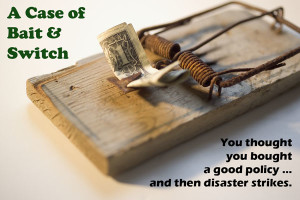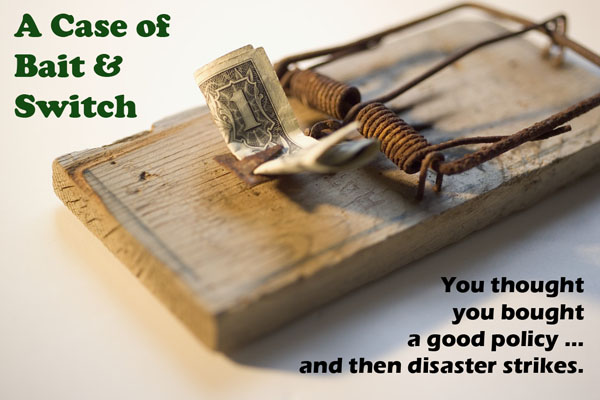 Are you a Wilshire Insurance Company policyholder?
Are you a Wilshire Insurance Company policyholder?
If so, you’ll want to pay attention to what I’m about to tell you. If you have a homeowner’s policy, you may have read (or likely did not read) the Loss Settlement Endorsement that came with your new policy or renewal. No, it’s not sexy, but you’ll thank me later if you have this policy now and replace it before something bad happens!
Let’s back up just a little bit and let me lay some ground work. When you buy an HO3 homeowner’ policy (the most typical type of replacement cost policy), you have an expectation that if something happens to your home you will receive enough money from the insurance company to make all necessary repairs. When the adjuster comes out to inspect your damage, he will likely explain that your claim will be divided up into the ACV portion (the initial check the insurance company pays you) and the Depreciation portion (the second check).
The ACV amount is determined by taking the total cost of repairs, and deducting the amount of depreciation. For instance. Let’s say your roof is destroyed in a storm. The roof is a 30-year shingle roof and it’s 10 years old. So, it would likely be depreciated somewhere around 33%. So, the first check you get for your repairs would be for 66% of the total cost to make the repairs. You would then find a roofing contractor who would do the repairs and you’d likely give him maybe 1/3 to get started and the other 1/3 at completion. Then, you submit a completion statement to your insurance company (and maybe some photos showing the work has been done). The insurance company, in turn, will send the withheld depreciation amount and then you pay your contractor the balance. Somewhere in there, you also pay your contractor the amount of your deductible. This is a very basic example of how a replacement policy works.
However, with Wilshire Insurance Company’s replacement cost policy, they have added an interesting twist with this endorsement. Every policy is made up of the “boiler plate” policy that is often used in various states. In order to tailor the policy to the laws and policies of each state, or to add or remove coverage, they often include Endorsements. These endorsements go at the end of your policy – or are included with your renewal documents. They are often left UNREAD by most policyholders who don’t understand that they are, in fact, part of the policy and often change the policy in ways they can’t imagine (such as is the case with this particular endorsement).
This endorsement, LSH01 05 14, reads as follows:
“LOSS SETTLEMENT
This endorsement applies to Forms:
HO 00 02 04 91
HO 00 03 04 91
HO 00 06 04 91
With regard to any loss arising out of wind, hail, and water leakage or water damage of any kind, Item 3. Loss Settlement is amended to read as follows:
3. Loss Settlement. Covered property losses are settled at actual cash value at the time of loss but not more than the amount required to repair or replace the damaged property.
All other Terms and Conditions of this Policy remain unchanged.”
Do you see what they did there? They changed the policy for wind, hail and WATER DAMAGE OF ANY KIND to be settled on an ACV only basis. English translation: You aren’t getting that second payment we talked about above! You are ONLY going to get the depreciated value on your claim – not the replacement cost value – even though for all other types of claims (such as fire, explosion, etc.) you will receive replacement cost coverage (i.e. the second check).
If you are insured by Wilshire Insurance (or any of the companies in the IAT Group of insurance), RUN to your filing cabinet, desk drawer, junk drawer, or email box (wherever you keep your important papers) and dig out that policy, dust it off, and check to see if you have this endorsement. If you do, call your agent – or better yet, fire your agent – and get a decent insurance policy that won’t leave you holding the bag in the event of a major water loss. It’s not unusual at all to have a $50,000 water loss if something breaks when you’re not home. Imagine water running from a failed supply line to your refrigerator at 60 psi for two weeks while you’re blissfully enjoying Disneyland or the Grand Canyon. Coming home to this will be traumatic – add to that stress the fact that you’re not adequately covered for the damages!
In this scenario, the claim could easily be valued at a replacement cost of $80,000 – with the insurance company only paying out around $60,000 in the ACV payment. Where will the other $20,000 come from if you don’t get that second check? Open up your wallet, because that the place it’s going to come from. That’s why this type of policy is absolutely horrible! Don’t get caught in this situation because it will be painful. And even a good public adjuster won’t be able to help you, because the language in the policy is what defines what the insurance has to pay for your claim – or doesn’t have to pay, as the case may be.
Until next time …
Tavisha



Excelente article, thanks